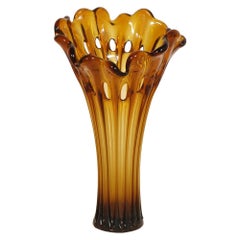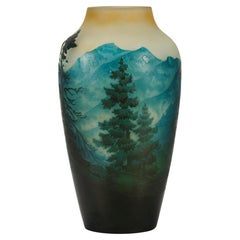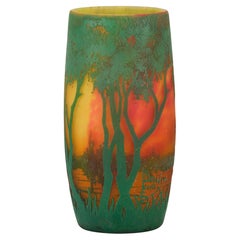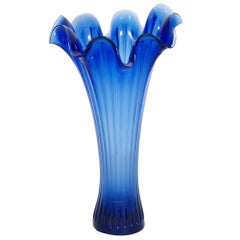Salviati Desk Sets
Not only did Salviati support the revival of Venice’s flagging Murano glass industry in the 19th century, but the company also became world-renowned for its innovative glassmaking techniques, revolutionizing the art of mosaics and glassware design.
The story of Salviati glass begins with Vicenza-born lawyer and entrepreneur Antonio Salviati. His love of Murano glass art and mosaics inspired him to establish his own mosaic and glass manufacturing firm, the Salviati Dott. Antonio fu Bartolomeo company, in Venice in 1859. Glassmakers in the region had been weathering a dismal political climate and growing competition in neighboring countries, and Salviati had initially hoped to revive Murano glassmaking in order to restore deteriorating mosaics in local cathedrals.
In 1864, Salviati exhibited a monumental glass mosaic at the “First Glassmakers’ Exhibition,” which won the gold medal. His award-winning mosaic solidified his company’s reputation as a first-rate glassmaker, which soon drew the attention of international investors, particularly investors from Great Britain.
In 1866, Salviati and C. opened in London with the support of historian William Drake and diplomat Sir Austen Henry Layard. Meanwhile, the Salviati company established its headquarters on the Rio dei Vetrai in Murano.
Throughout the late 1800s, Salviati and C. expanded its production to include household glassware and serveware and decorative objects such as cups, glasses, amphoras and vials. Salviati also received commissions to produce mosaics for St Paul’s Cathedral and the Houses of Parliament in London, the Paris Opera House and the Viceroy of Egypt’s Palace in Alexandria.
After Antonio Salviati died in 1890, his sons Giulio and Silvio took over the company. The Barovier family — a dynasty that stretches as far back as 1295 — bought the manufacturer in 1883, and a glass master named Maurizio Camerino, who had honed his skills at Salviati, was appointed to lead the company. Camerino’s children took the reins following the glass master’s death in 1931 and launched a successful lighting line of table lamps and chandeliers after World War II.
Throughout the 20th century, Salviati participated in several Venice Biennale exhibitions from 1958 to 1972. In 1962, the company was awarded the Compasso d’Oro prize for the Marco vase, designed by architect Sergio Asti.
Since its acquisition by the Umana group in 2015, Salviati has collaborated with numerous renowned designers such as Federico Peri, Davide Bruno, Renzo Stellon, Alberto Lago and Anna Gili. Salviati's pieces can be found in the collections of the Museum August Kestner in Hanover, Germany, the Museum of Modern Art and Corning Museum of Glass in New York, the Eretz Museum in Tel Aviv, Israel, and the Murano Glass Museum in Venice.
Find antique Salviati glass that includes bowls, vases, lighting and more.
Early 1900s Italian Art Nouveau Antique Salviati Desk Sets
Murano Glass
Early 20th Century French Art Nouveau Salviati Desk Sets
Glass
Early 20th Century French Art Nouveau Salviati Desk Sets
Glass
Late 20th Century Italian Mid-Century Modern Salviati Desk Sets
Murano Glass
Mid-20th Century Italian Art Deco Salviati Desk Sets
Art Glass, Blown Glass, Glass, Murano Glass, Opaline Glass
Early 20th Century American Art Nouveau Salviati Desk Sets
Glass
Early 20th Century French Art Nouveau Salviati Desk Sets
Glass
Early 20th Century French Art Nouveau Salviati Desk Sets
Glass
20th Century French Art Nouveau Salviati Desk Sets
Ceramic
Early 20th Century French Art Nouveau Salviati Desk Sets
Art Glass
Early 20th Century French Art Nouveau Salviati Desk Sets
Glass
Late 20th Century Italian Mid-Century Modern Salviati Desk Sets
Art Glass, Blown Glass, Murano Glass, Sommerso, Glass
1880s Italian Renaissance Revival Antique Salviati Desk Sets
Blown Glass, Murano Glass
Early 20th Century Italian Art Nouveau Salviati Desk Sets
Murano Glass



